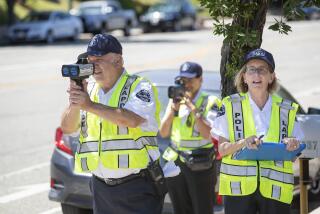Senators OK 65 M.P.H. in Victory for Western States : Limit Would Apply in Rural Areas
- Share via
WASHINGTON — The Senate today approved a measure allowing states to increase speed limits on stretches of rural interstates to 65 m.p.h., a proposal that would mainly speed traffic along wide-open Western highways.
The provision, approved by a 65-33 vote, largely pitted lawmakers from Western states against their Eastern counterparts.
Westerners argued that states with long, straight sections of rural highway should be allowed to increase the current 55-m.p.h. limit, instituted in 1974. But lawmakers from the East countered that the lower maximum speed has saved lives and conserved gasoline.
“I think it has perhaps been valid in certainly fuel consumption and saving of lives,” Sen. Alan K. Simpson (R-Wyo.), one of 18 Western legislators who co-sponsored the measure, said of the current limit. “But where it doesn’t fit at all is to recognize the diversity of the United States of America.”
Choice Up to States
The measure’s lead sponsor, Sen. Steven D. Symms (R-Ida.), said the provision is “a modest, moderate amendment” because it would allow states to decide their own speed limits on parts of interstates.
The provision is an amendment to a $52.4-billion, four-year program that would provide aid to the states for roads and bridges. A $10.8-billion measure that would provide assistance to the nation’s mass transit systems was expected to be attached to the highway measure.
Last year, the speed limit provision passed by a 56-36 vote. But House leaders opposed the increase, and that dispute was one reason the 1986 highway bill died in the Senate-House conference.
Delay on Aid Feared
There has been concern that a Senate bill including the speed limit amendment could jeopardize federal aid for roads and mass transit systems from quickly reaching the states.
“I want to get the bill passed, and I want to get it through conference and get it on the President’s desk,” Senate Majority Leader Robert C. Byrd (D-W.Va.) said before today’s vote. “I don’t want to see it held up. . . . “
“Every time we try to tailor one suit here in Washington to fit all 50 states, inevitably it fits poorly in many of those states, if not in a majority,” an Eastern supporter of the higher speed limit, Sen. Gordon J. Humphrey (R-N.H.) said during this morning’s debate. “Probably there’s no better example of that truth than the 55-m.p.h. speed limit.”
Fewer Deaths Cited
Supporters’ arguments, however, were opposed by senators who cited National Safety Council estimates that since 55 m.p.h. became the maximum in 1974, 36,000 traffic deaths have been avoided and as many as 82,000 injuries prevented.
“Basically this is a question of weighing the scales with time saved on one side and lives saved on the other,” said Sen. John C. Danforth (R-Mo.).
State officials and road builders have complained that they need money for the coming spring construction season as soon as possible, and some lawmakers believed a bill should be passed without any controversial amendments. The House already has passed a five-year, $91-billion highway and mass transit aid bill.
Speedy Passage Sought
“I do not want this highway bill held up because of strongly held views by either members of the House or strongly held views by those of us over here. . . . We’ve got to get on with construction,” said Sen. J. James Exon (D-Neb.), who supports a higher speed limit but did not co-sponsor Symms’ amendment.
Sen. Robert T. Stafford (R-Vt.) also planned to offer an amendment that would allow no new billboards on many roads in rural areas. In addition, it would allow states in some cases to forgo the payments that are now required to billboard owners whose signs are removed. Instead, the billboards could be amortized--allowed to stand for several extra years before they are removed.
More to Read
Sign up for Essential California
The most important California stories and recommendations in your inbox every morning.
You may occasionally receive promotional content from the Los Angeles Times.













